
Original Link: https://www.anandtech.com/show/1796
Intel Motherboards: Can a Diamond beat a Royal Flush?
by Gary Key on September 23, 2005 12:05 AM EST- Posted in
- Motherboards
With the recent introduction of the Intel Pentium Dual-Core processor, both Intel and NVIDIA have released feature-laden chipsets to accommodate this affordable processor range while still catering to the full Socket LGA775 lineup.
In catering to the enthusiast and potential workstation client, both MSI and Gigabyte have released their flagship boards based upon the nForce4 SLI Intel Edition and Intel 955x chipsets respectively. Unfortunately, both companies have also tried to cater to every possible market segment in the design and implementation of features on each board.
In a testament to the strength of each chipset, the respective manufacturers are trying to differentiate and market the boards based upon auxiliary feature sets. These feature sets include additional connectivity and storage ports, improved audio capabilities, unique software sets to control various aspects of the board, extensive documentation, and complete cable/PCI back plate installation kits.
Today, we will compare the features, performance, and capabilities of the MSI P4N Diamond and Gigabyte GA-8I955X Royal motherboards. This review will not cover in depth the differences between the core logic chipsets or address processor architectures. This information was covered in the Dual Core Intel Platform Shootout - NVIDIA nForce4 vs. Intel 955X and Intel Dual Core Performance Preview Part I: First Encounter. Let's see if these boards can be considered the jack-of-all-trades or is one of them holding an ace up their sleeve that will allow it to win?
Basic Features: MSI P4N Diamond & Gigabyte GA-8I955X Royal
Both boards have impressive feature sets with the MSI P4N having a slight advantage due to the integrated drive options, SLI, and networking support present in the nForce4 SLI Intel Edition Chipset.
| Specification | Gigabyte GA-8I955X Royal | MSI P4N Diamond |
| CPU Interface | LGA775-based Pentium 4, Pentium XE, Celeron D, and Pentium D processors | LGA775-based Pentium 4, Pentium XE, Celeron D, and Pentium D processors |
| Chipset | North bridge- Intel 955x South bridge- Intel ICH7R |
North bridge- NVIDIA nForce4 SLI Intel Edition SPP South bridge- NVIDIA nForce4 SLI Intel Edition MCP |
| Pentium D Support (Dual-Core) |
Full Support | Limited Support (Pentium D 820 in single-core mode only as of this writing) |
| TM2 (Thermal Monitor 2) Support | Full Support | Not Supported |
| BUS Speeds | 100-600MHz (in 1MHz increments) | 400-1400 MHz (in 1MHz increments) |
| CPU Ratios | Unlock Supported, Adjustable down depending on CPU | Unlock Supported, Adjustable down depending on CPU |
| Memory Speeds | Auto- 400, 533, 667, 888, plus predefined multipliers | 400-1200 (Asynchronous) |
| PCI/AGP Speeds | Asynchronous (Fixed) | Asynchronous (Fixed) |
| PCI Express | 90MHz to 150MHz in 1MHz increments | 100MHz to 150MHz in 1MHz increments |
| Dynamic Overclocking | C.I.A.2, (4) unique settings, dynamic increase from 5 to 19% | D.O.T. Express, (6) unique settings, increase from 1 to 15% |
| Core Voltage | Auto, 0.8375V-1.60V in 0.0125V increments | Auto, 0.8375V-1.60V in 0.0125V increments |
| DRAM Voltage | Auto, 1.80V to 2.3V in 0.1V increments | Auto, 1.80V to 2.4V in 0.05V increments |
| Other Voltage | PCI-E - +0.05V to +.035V in .05V steps, FSB - +0.05V to +.035V in .05V steps |
North Bridge - 1.475V - 1.525V in .025V steps, 1.55V - 1.70V in .5V steps |
| LDT (Hyper Transport) Ratios | NA | 1x, 2x, 3x, 3.5x, 4x, 5x |
| Memory Command Rate | NA | Auto, 1T, 2T |
| Memory Slots | Four 240-pin DDR2 Slots Dual-Channel Unbuffered Memory to 8GB |
Four 240-pin DDR2 Slots Dual-Channel Unbuffered Memory to 16GB |
| Expansion Slots | 1x16 PCIe Slots 2 x1 PCIe 3 PCI Slots |
2 x16 PCIe Slots (configured as 1 x16 or 2 x8) 1x1 PCIe 2 PCI Slots |
| SLI | Not supported | NVIDIA (x8 + x8) SLI |
| Onboard SATA | 4-Drive SATA 2 RAID by ICH7R 2-Drive SATA 2 RAID by Sil3132 |
4-Drive SATA 2 RAID by nF4 PLUS 2-Drive SATA 2 RAID by Sil3132 |
| Onboard IDE | (1) INTEL ATA 100/66/33 port, (2) drive support (2) ITE IT8212F ATA 133/100/66 ports, (4) drive support |
(2) NVIDIA ATA 133/100/66 ports, (4) drive support |
| SATA/IDE RAID | 4-Drive SATA 2 RAID by ICH7R RAID 0, 1, 5, 10 Intel Matrix 2-Drive SATA 2 RAID by Sil3132 2-Drive PATA GigaRAID by IT8212F |
4-Drive SATA 2 RAID by nF4 PLUS 4-Drive IDE RAID (8) drive support Can be combined in RAID 0, 1, 0+1, 5, and JBOD (8 drives total) (2) SATA 2 Drives by Sil3132 as RAID 0, 1 |
| Onboard USB 2.0/IEEE-1394 | (8) USB 2.0 ports supported by ICH7R (3) 1394A/B FireWire ports supported by TI 1394b |
(10) USB 2.0 ports supported by nF4 (3) 1394A FireWire ports supported by VIA VT6306 |
| Onboard LAN | Dual Gigabit Ethernet PCIe Gigabit LAN by (2) Broadcom 5751 |
Dual Gigabit Ethernet NVIDIA PCIe LAN by Marvel 88E1111 PHY PCIe Gigabit LAN by Marvell 88E8053 |
| Onboard Audio | Azalia HD 8-channel audio, Realtek ALC882M codec featuring Dolby Digital Live!, (1) Coaxial & (1) Optical S/PDIF output port and (1) S/PDIF input |
Creative Sound Blaster Live! 24bit 8-channel audio, Creative DSP controller (CA0106-DAT), (1) Coaxial S/PDIF & (1) TOS-Link Digital output port |
| Power Connectors | ATX 24-pin, 1 or 2 x4-pin 12V | ATX 24-pin, 1 x4-pin 12V, 1 x4-pin GPU |
| Other Features | USB adapter for Bluetooth 1.2 devices, USB extension cord, Gigabyte EasyTune 5 software for real time detection and adjustment of various hardware settings | Core Cell Chip for dynamic system tuning, MSI CoreCenter software for real time detection and adjustment of various hardware settings |
| BIOS | AWARD F7 | AMI 1.3 |
Without exception, the Intel 955x fully supports all dual core Pentium D processors. The nForce4 SLI Intel Edition Chipset dual core support is limited at this time. We confirmed that both boards worked properly at stock settings with an Intel Pentium D 840 processor, and there were no problems with either board recognizing the two cores and four logical processors that are created with the Hyperthreading feature on this EE processor. However, the MSI P4N Diamond only supports the Intel Pentium D 820 processor in single core mode. NVIDIA confirmed the current chipset was not validated for dual core operation with the Intel Pentium D 820 processor. Considering the cost / performance advantage of the Intel Pentium D 820 processor, the lack of full support at this time from NVIDIA is a mistake in our opinion.
MSI P4N Diamond: Layout & Features
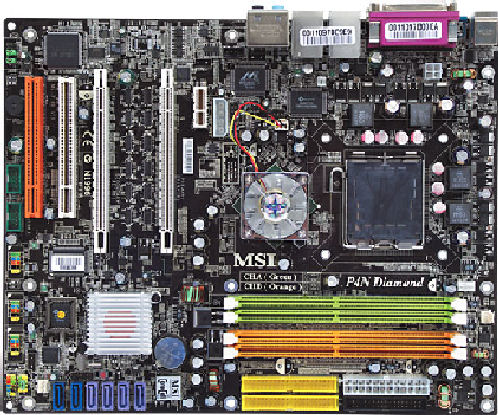
Although I disagree with the choice of colors for the peripheral connections, as they ruin an otherwise sharp looking board, they do have their place for identifying ports quickly and properly. However, in my opinion, MSI did err with the DIMM module slots' color coordination. It would have been nice to separate the dual channel slot colors instead of relying on the standard DIMM one through four labels - you would instinctively know that by placing memory in the green slots, it would equate to dual channel operation.
The power plug placement favors standard ATX case design and except for running a four-pin 5v lead to the auxiliary power plug above the PCIe x1 slot, the power cable management is very good. The floppy and IDE connectors are conveniently located along the back of the board and allow usage of ribbon or rounded cables.
The SPP Northbridge is actively cooled, and based upon how hot the nForce4 SLI Intel Edition chipset runs, this type of additional cooling is required. However, upon installing the stock Intel heatsink, it was basically touching the SPP fan unit. It appears that there was ample room for the north bridge to have been moved slightly to the left without interfering with the PCI Express x1 slot, which would have allowed a greater variety of cooling solutions. The MCP Southbridge heatsink is a low profile design that features a copper core to assist in cooling and will not interfere with the longer video cards.
The board comes with (1) PCI Express x1 slot that is followed in order with (2) PCI Express x16 slots and (2) 32bit master slots. The lack of additional PCI Express slots is attributed to the on-board PCI Express peripherals utilizing two PCI Express lanes. The area between the (2) PCI Express slots contains the MSI paddle-less SLI switch components. This feature worked flawlessly throughout the test phase.
Another feature that worked flawlessly was the CMOS reset button located next to SATA connector numbers three and four. This is an idea that all motherboard manufacturers should incorporate on their boards, as moving a jumper to clear the CMOS can be a bit cumbersome. (Jumpers are so 1990s....)
Speaking of which, all of the SATA ports are located in a row along the back of the board and feature the new clamp and latch design. Unfortunately, MSI did not include the new cable design in their kit. However, this design could pose potential issues with certain ATX case designs that have the drive bays nudging along the perimeter of the board. Another issue is that the connectors are difficult to use when utilizing an SLI setup. The image shown can best describe the situation as the bottom drive had to be moved due to the SLI configuration and you can see that cable management could be an issue.
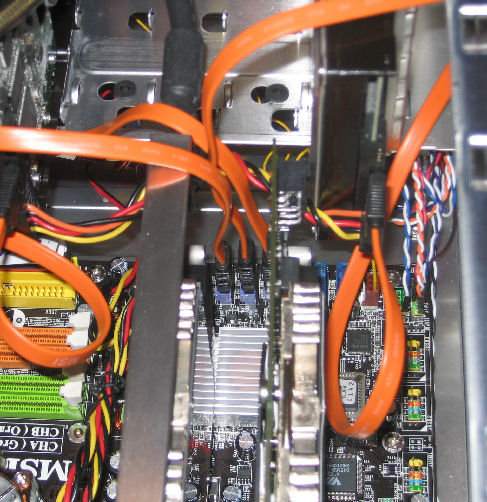
MSI installs their CoreCell chip that allows dynamic overclocking based on CPU loads. The CoreCell can detect CPU speeds within a microsecond depending upon changes in the CPU workload.
MSI also ships their CoreCenter software package, which allows users to configure and adjust the front side bus speed and change various system voltage settings. It will not allow changes to the CPU multiplier as this is only allowed within the BIOS. The utility will also allow you to set various temperature and fan speed based warnings.
The P4N Diamond also includes the Creative Sound Blaster Live! 24bit (CA0106-DAT) DSP chipset for on-board audio duties. The Wolfson Microelectronics WM8775EDS 24-bit, 96KHz ADC and Cirrus Logic CS4382 24-bit, 192KHz DAC are included onboard. The audio system boasts 24-bit 8-channel audio with a reported 100db signal to noise ratio. The board provides both coaxial and TOS-Link digital S/PDIF audio outputs, but does not provide a S/PDIF audio input connector. This chipset combination fully supports Dolby Digital EX and Creative's EAX Advanced HD.
MSI also offers a unique customer service option for owners of their Diamond series boards. A membership card is included in the box that allows access to a separate forum on the MSI website that provides dedicated MSI technical service for the members.
MSI P4N Diamond: Overclocking
| Front Side Bus Overclocking Testbed | |
| Processor: | Pentium 4 Prescott LGA 775 840EE Dual Core 3.2GHz |
| CPU Voltage: | 1.4V (1.350V default) |
| Cooling: | Intel Stock Cooler |
| Power Supply: | OCZ Power Stream 520 |
| Maximum CPU OverClock | 238FSB x1 6 (3808MHz) +19% |
| Maximum FSB OC: | 0FSB x 14 (0MHz) |
With a stock multiplier, the P4N Diamond reached an overclock of 238x16 or 3808MHz. Unfortunately, once we changed the multiplier, the system would disable the second core. We tested several BIOS versions from MSI, but the results remained the same. This only reinforced our findings that the nForce4 SLI Intel Edition chipset did not fully support the entire Pentium D processor lineup. To further check, we tried the Intel Pentium D 820, a low-cost dual-core dual-core Intel processor very popular with overclockers. The MSI board would not run the 820 in dual-core mode, switching it to single core operation only.
We sent our test findings to both MSI and NVIDIA for resolution. NVIDIA responded and stated both issues are a known limitation in the current NVIDIA chipset for Intel SLI and will be fixed in future product releases. NVIDIA added that the Intel Pentium D 820 was not released when the NVIDIA Intel SLI package was designed and they did not validate the chipset. They did not believe at the time it was likely buyers of a top-end board with the NVIDIA nforce4 Intel Edition SLI chipset would use it with a value dual-core processor like the 820. However, the Pentium D 820 problem will also be fixed in future NVIDIA chipset revisions.
While we were able to reach these OC levels with the Intel HSF, the long-term stability of the system at these speeds is very suspect. After running several tests, the system began throttling, alternating between stock speed and reduced speed due to overheating. There is no doubt that the CPU can do these speeds or better, but it will require an alternative cooling system.
Memory Stress Testing
Memory stress tests look at the ability of the MSI P4N Diamond to operate at the officially supported memory frequencies of 533MHz and 667MHz DDR2, at the best performing memory timings that the Patriot Extreme Performance PEP21G5600+XBL will support.
| MSI P4N Diamond Stable DDR533 Timings - 2 DIMMs (2/4 slots populated - 1 Dual-Channel Bank) |
|
| Clock Speed: | 200MHz (800FSB) |
| Timing Mode: | 533MHz - Default |
| CAS Latency: | 3 |
| RAS to CAS Delay: | 2 |
| RAS Precharge: | 2 |
| RAS Cycle Time: | 4 |
| Voltage: | 1.8V |
| Command Rate: | 1 |
The MSI P4N Diamond was completely stable with 2 DDR2 modules in Dual-Channel at the settings of 3-2-2-4 at 1.8V.
Filling all four available memory slots is more strenuous on the memory subsystem than testing 2 DDR2 modules on a motherboard.
| MSI P4N Diamond Stable DDR533 Timings - 4 DIMMs (4/4 slots populated - 2 Dual-Channel Banks) |
|
| Clock Speed: | 200MHz (800FSB) |
| Timing Mode: | 533MHz - Default |
| CAS Latency: | 3 |
| RAS to CAS Delay: | 2 |
| RAS Precharge: | 2 |
| RAS Cycle Time: | 4 |
| Voltage: | 1.95V |
| Command Rate: | 1 |
The MSI P4N Diamond was completely stable with 4 DDR2 modules in Dual-Channel at the settings of 3-2-2-4, but the voltage had to be increased to 1.95V.
We will now increase the memory frequencies to 667MHZ to see what effect this change has on the memory timings and stability of the board.
| MSI P4N Diamond Stable DDR677 Timings - 2 DIMMs (2/4 slots populated - 1 Dual-Channel Bank) |
|
| Clock Speed: | 200MHz (800FSB) |
| Timing Mode: | 667MHz - Default |
| CAS Latency: | 4 |
| RAS to CAS Delay: | 3 |
| RAS Precharge: | 3 |
| RAS Cycle Time: | 8 |
| Voltage: | 1.9V |
| Command Rate: | 1 |
The MSI P4N Diamond was completely stable with 2 DDR2 modules in Dual-Channel at the settings of 4-3-3-8 at 1.9V and leaving the Command Rate at 1.
Filling all four available memory slots is more strenuous on the memory subsystem than testing 2 DDR2 modules on a motherboard.
| MSI P4N Diamond Stable DDR667 Timings - 4 DIMMs (4/4 slots populated - 2 Dual-Channel Banks) |
|
| Clock Speed: | 200MHz (800FSB) |
| Timing Mode: | 667MHz - Default |
| CAS Latency: | 4 |
| RAS to CAS Delay: | 3 |
| RAS Precharge: | 3 |
| RAS Cycle Time: | 8 |
| Voltage: | 1.9V |
| Command Rate: | 2 |
The MSI P4N Diamond was completely stable with 4 DDR2 modules in Dual-Channel at the settings of 4-3-3-8 at 1.9V, but the Command Rate had to be switched to 2. This resulted in a 1 to 3% decrease in benchmark scores during testing.
Gigabyte GA-8I955X Royal: Layout & Features
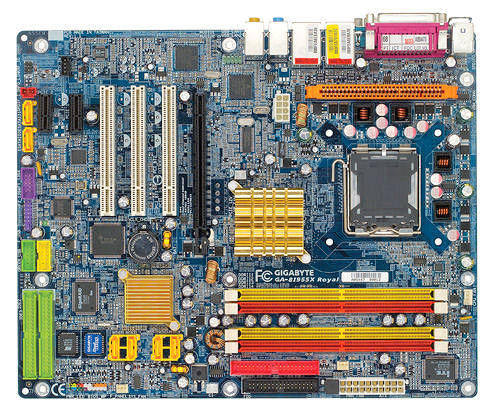
However, Gigabyte did get the DIMM module slots' color coordination correct for dual channel setup. The power plug placement favors standard ATX case design and the power cable management is very good. Gigabyte actually places the eight-pin 12v auxiliary power connector to the left of the CPU socket area, which should assist in easier installs for newer case designs that mount the power supply at the bottom of the case. In a standard ATX case design, there is the possibility of cable clutter around the CPU socket area.
The floppy and Intel ICH7R IDE connectors are conveniently located along the back of the board and allow usage of ribbon or rounded cables.
The Northbridge is passively cooled, but Gigabyte does provide their Cool Plus fan that should be used based on our overclock testing. However, upon installing the fan, it can interfere with a larger style heatsink. We did find the Northbridge heatsink to be slightly loose during testing and required additional pressure to lock in place. The Southbridge heatsink is a low profile design and will not interfere with longer cards.
The board comes with (1) PCI Express x16 slot that is followed by (3) 32bit PCI slots, and (2) PCI Express x1 slots. This design allows the use of larger video card coolers without blocking the PCI Express slots.
Unlike the MSI P4N Diamond, the CMOS reset is a traditional jumper design located between the first and second PCI slot that proved to be inconvenient at times.
The Intel ICH7R SATA ports are conveniently located to the bottom of the Southbridge and feature the new clamp and latch design. Gigabyte did include two of the new cable designs in their kit, which greatly enhanced the security of the SATA connections. The GigaRaid IT8212F IDE and Silicon Image 3132 SATA connectors are located to the far left of the CPU socket and could potentially cause cable clutter in a standard size ATX case and possibly create cable length issues in a full tower case.
Returning to the CPU socket area, we find an orange slot that holds Gigabyte's Universal Plus Dual Power System or U-Plus DPS for short. This card contains an eight-phase power circuit designed to improve the quality and stability of power to the CPU. The system will operate fine without it, but it was required for our overclocking results. The issue is this: once you install the card, it will block the installation of most cooling solutions and actually works as a barrier for proper airflow in the area. The most disappointing aspect is that Gigabyte produces excellent CPU coolers and as the image shows, their own G-Power unit will not work on this board.
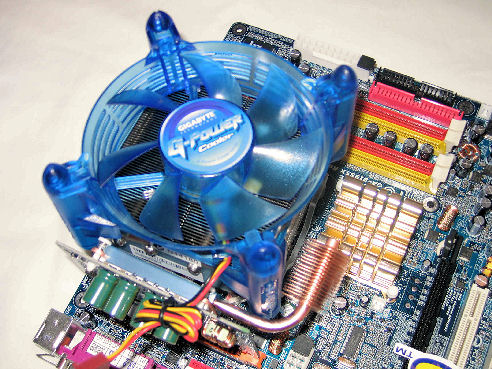
Gigabyte ships their EasyTune 5.0 software package, which allows users to configure and adjust the front side bus speed, CPU multiplier (requires reboot), and change various system voltage settings. It will not allow real time changes to the CPU multiplier as this is only allowed within the BIOS. The utility will also allow you to monitor various system functions and provides the ability to control the CPU and North Bridge fans.
The GA-8I955X Royal includes the Realtek ALC 882M codec for on-board audio duties. The audio system boasts 24-bit 7.1+2 Channel audio featuring five 24-bit stereo DACs with a 103dB SNR rating and three 20-bit stereo ADCs DACs with 90dBA SNR rating. The 10 DAC channels support a 16/20/24-bit PCM format for 7.1 sound playback, plus 2 channels of independent stereo sound output (multiple streaming) through the Front-Out-Left and Front-Out-Right channels. The two 16/20/24-bit S/PDIF-OUT connections (coaxial/optical) support 44.1k/48k/96k/192kHz sample rates. The single 16/20/24-bit S/PDIF-IN connection supports 44.1k/48k/96k/192kHz sample rates. The audio system fully supports Intel's Azalia High Definition Audio standard and comes with an extensive and (as of this writing) exclusive Dolby Master Studio software package. However, as impressive as the Realtek ALC 882M specifications sound, it is a host audio solution and will consume significantly more CPU resources than the hardware based DSP solution on the MSI board.
Gigabyte also included a USB Bluetooth adapter. The dongle is very small and unobtrusive and works well with our Bluetooth-enabled cell phones. A USB extender cable is included for this adapter and has the standard USB connectors that make it useful for other USB devices.
Gigabyte GA-8I955X Royal: Overclocking
FSB Overclocking Results:
| Front Side Bus Overclocking Testbed | |
| Processor: | Pentium 4 Prescott LGA 775 840EE Dual Core 3.2GHz |
| CPU Voltage: | 1.425V (1.350V default) |
| Cooling: | Intel Stock Cooler |
| Power Supply: | OCZ Power Stream 520 |
| Maximum CPU OverClock | 241FSB x 16 (3856MHz) +20% |
| Maximum FSB OC: | 272FSB x 14 (3808MHz) +19% |
With a stock multiplier, the GA-8I955X Royal reached an overclock of 241x16 or 3856MHz. With a lowered multiplier, the GA-8I955X Royal reached an overclock of 272x14 or 3808MHz. Unlike the MSI P4N, the Gigabyte board did not disable the second core. It should also be noted that in both tests, the memory settings were set to auto with the Gigabyte GA-8I955X Royal running more conservative timings than the MSI P4N Diamond, which assisted in the higher CPU overclock.
While we were able to reach these OC levels with the Intel HSF, the long-term stability of the system at these speeds is very suspect. After running several tests, the system began throttling - alternating between stock speed and reduced speed due to overheating. There is no doubt the CPU can do these speeds or better but it will require an alternative cooling system.
Memory Stress Testing
Memory stress tests look at the ability of the GA-8I955X Royal to operate at the officially supported memory frequencies of 533MHz and 667MHz DDR2, at the best performing memory timings that the Patriot Extreme Performance PEP21G5600+XBL will support.
| Gigabyte GA-8I955X Royal Stable DDR533 Timings - 2 DIMMs (2/4 slots populated - 1 Dual-Channel Bank) |
|
| Clock Speed: | 200MHz (800FSB) |
| Timing Mode: | 533MHz - Default |
| CAS Latency: | 3 |
| RAS to CAS Delay: | 2 |
| RAS Precharge: | 2 |
| RAS Cycle Time: | 4 |
| Voltage: | 1.8V |
The GA-8I955X Royal was completely stable with 2 DDR2 modules in Dual-Channel at the settings of 3-2-2-4 at 1.8V.
Filling all four available memory slots is more strenuous on the memory subsystem than testing 2 DDR2 modules on a motherboard.
| Gigabyte GA-8I955X Royal Stable DDR533 Timings - 4 DIMMs (4/4 slots populated - 2 Dual-Channel Banks) |
|
| Clock Speed: | 200MHz (800FSB) |
| Timing Mode: | 533MHz - Default |
| CAS Latency: | 3 |
| RAS to CAS Delay: | 2 |
| RAS Precharge: | 2 |
| RAS Cycle Time: | 4 |
| Voltage: | 1.9V |
The GA-8I955X Royal was completely stable with 4 DDR2 modules in Dual-Channel at the settings of 3-2-2-4, but the voltage had to be increased to 1.9V.
We will now increase the memory frequencies to 667MHZ to see what effect this change has on the memory timings and stability of the board.
| Gigabyte GA-8I955X Royal Stable DDR667 Timings - 2 DIMMs (2/4 slots populated - 1 Dual-Channel Bank) |
|
| Clock Speed: | 200MHz (800FSB) |
| Timing Mode: | 667MHz - Default |
| CAS Latency: | 4 |
| RAS to CAS Delay: | 3 |
| RAS Precharge: | 3 |
| RAS Cycle Time: | 8 |
| Voltage: | 1.9V |
The Gigabyte GA-8I955X Royal was completely stable with 2 DDR2 modules in Dual-Channel at the settings of 4-3-3-8 at 1.9V. The performance benchmarks were actually equal to or better than the 533MHZ setting on this board. However, this did not translate into better application performance compared to the MSI board.
Filling all four available memory slots is more strenuous on the memory subsystem than testing 2 DDR2 modules on a motherboard.
| Gigabyte GA-8I955X Royal Stable DDR667 Timings - 4 DIMMs (4/4 slots populated - 2 Dual-Channel Banks) |
|
| Clock Speed: | 200MHz (800FSB) |
| Timing Mode: | 667MHz - Default |
| CAS Latency: | 4 |
| RAS to CAS Delay: | 3 |
| RAS Precharge: | 3 |
| RAS Cycle Time: | 12 |
| Voltage: | 1.9V |
The GA-8I955X Royal was completely stable with 4 DDR2 modules in Dual-Channel at the settings of 4-3-3-12 at 1.9V, but the RAS Cycle Time had to be switched to 12.
Test Setup
The Intel 955x fully supports dual core Pentium D processors and based upon our testing, the nForce4 SLI Intel Edition offers limited support in certain configurations. However, there were no issues with either board recognizing the two cores and four logical processors that are created with the Hyperthreading feature on this EE processor during testing. However, dual core really makes a difference in certain multi-tasking scenarios, as was demonstrated in the dual core performance preview. If you are interested to know how the two chipsets perform in a real world multitasking setup, please take another look at that review.
Both board's were also operated at DDR2-667 for the benchmarking suites, but the variations in the benchmarks against the standard DDR2-533 settings were within 2% both ways, so those numbers will not be published. We also found that certain benchmarks had scored better without Hyper Threading enabled, but in fairness, we felt that it was best to show consistent scores with this feature enabled as it is the main selling point of this processor model.
| Performance Test Configuration | |
| Processor(s): | Intel Pentium EE 840 (3.2GHz, 800FSB, Dual-Core, HT, 2x1MB L2) HT enabled for all tests. |
| RAM: | 2 x 1GB Patriot Extreme Performance PEP21G5600+XBL |
| Hard Drive(s): | 3 x Maxtor MaXLine III 7L300S0 300GB 7200 RPM SATA (16MB Buffer) |
| System Platform Drivers: | Intel 7.2.1.1003 NVIDIA nForce4 SLI Intel Edition 7.13 |
| Video Cards: | XFX 7800GTX OC (PCI Express) 2 x MSI 7800GTX (PCI Express) for SLI Verification |
| Video Drivers: | NVIDIA nForce 78.01 |
| Operating System(s): | Windows XP Professional SP2 |
| Motherboards: | Gigabyte GA-8I955X Royal MSI P4 Diamond |
General Performance & Encoding
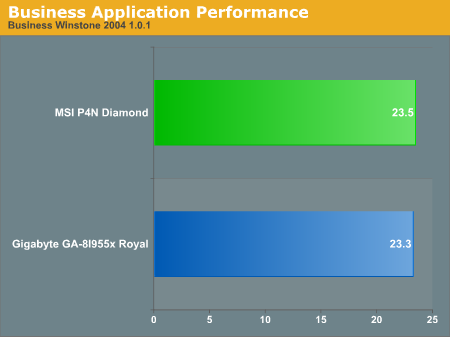
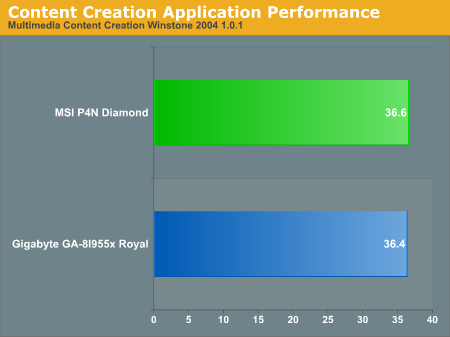
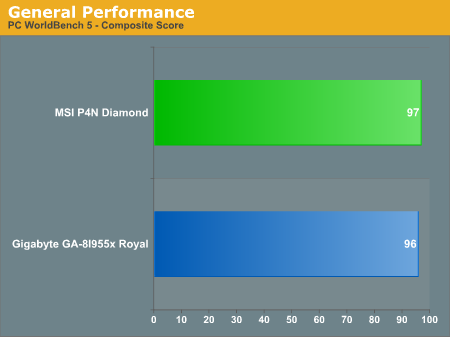
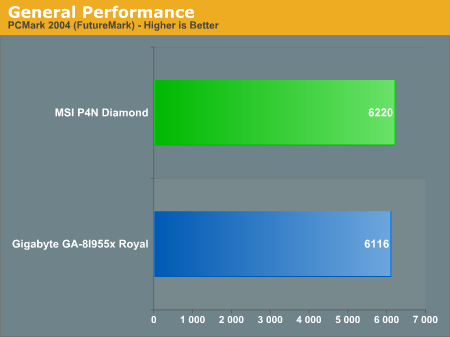
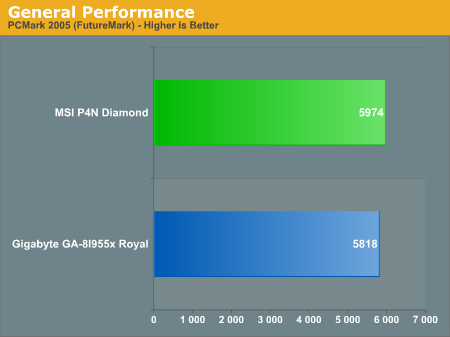
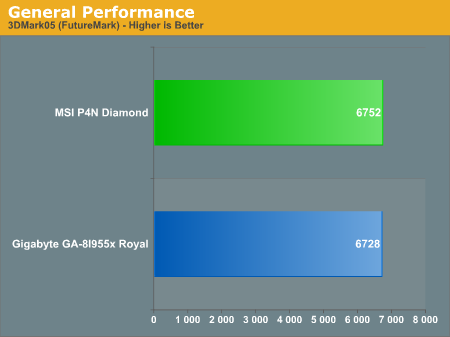
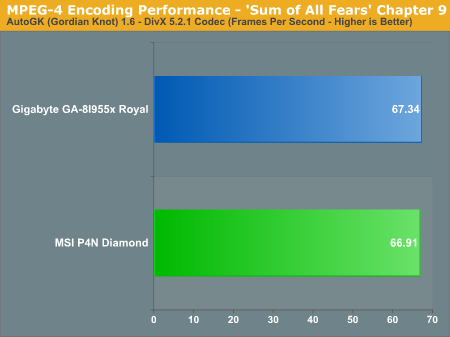
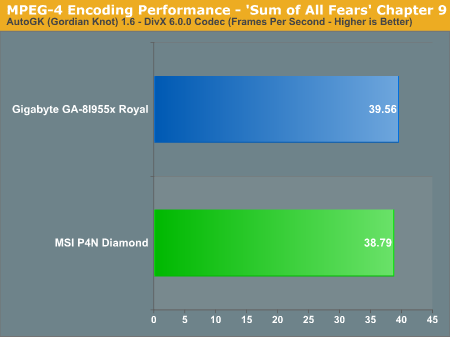
Memory Performance
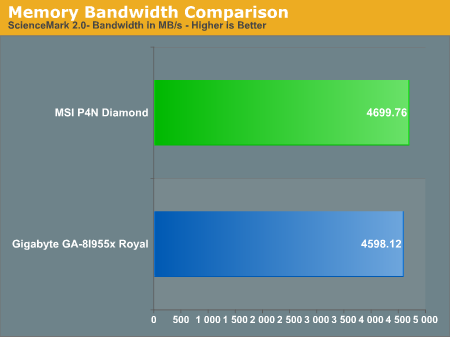
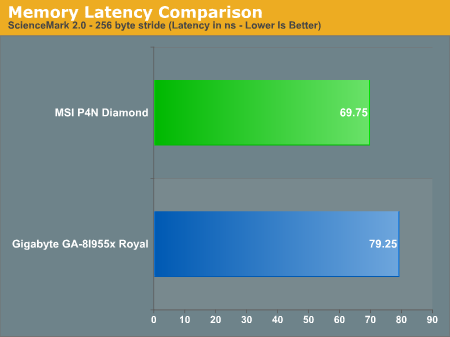
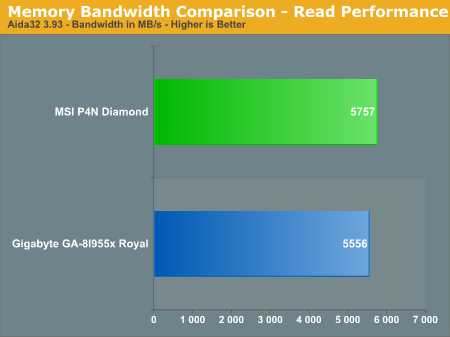
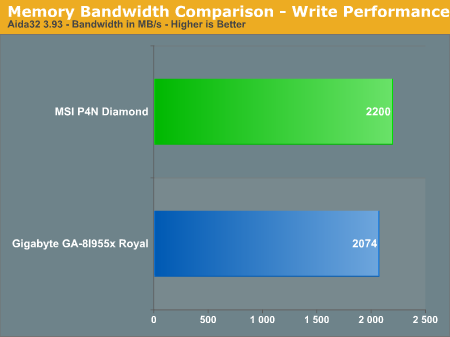
Gaming Performance
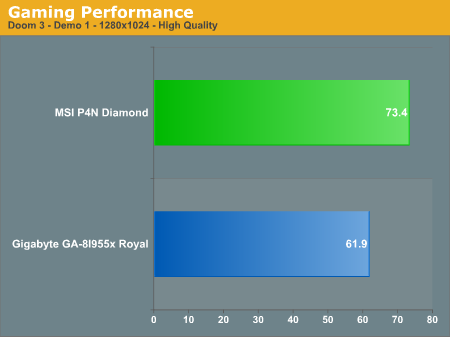
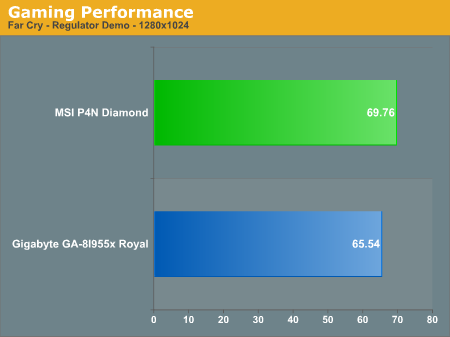
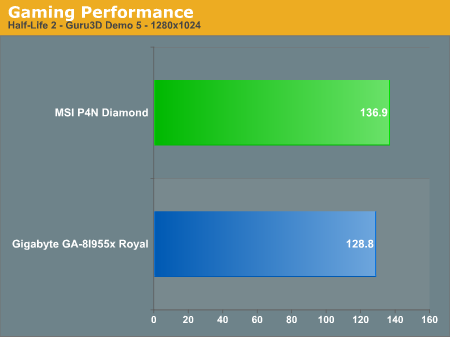
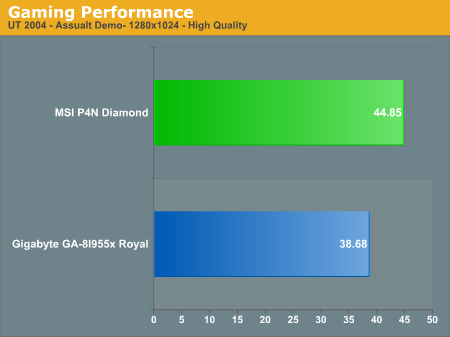
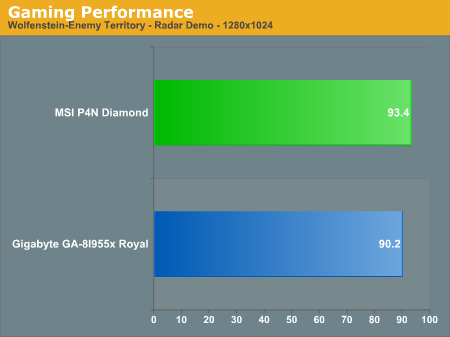
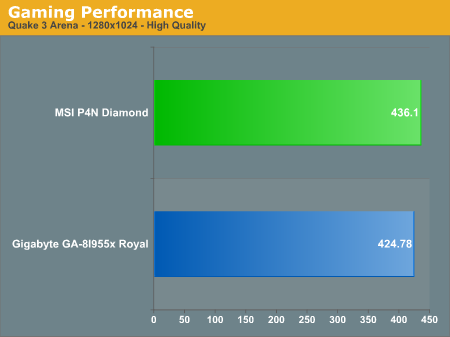
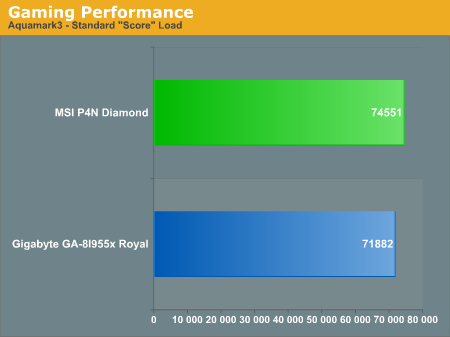
Overclocking Performance
The overclocking performance graphs have been added to the standard benchmark test suite and should allow for a better comparison on the overclocking capabilities of tested boards. For more details on the specific overclocking abilities of these boards, please refer to the Overclocking and Memory Stress Test section in the Basic Features section.
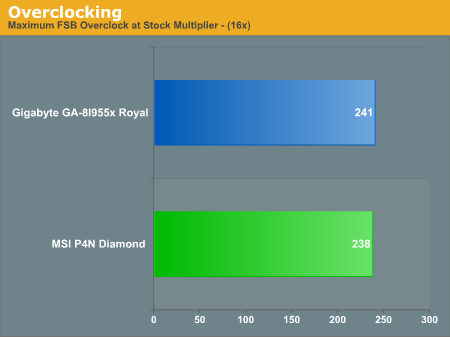
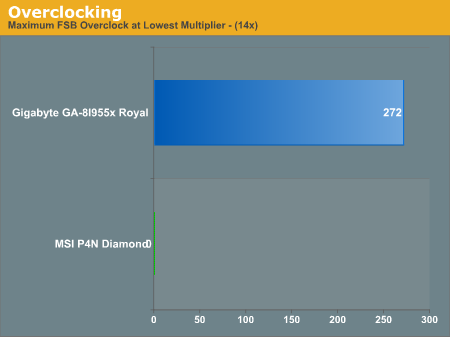
We believe that the MSI board would have made a better showing if the nForce4 SLI Intel Edition chipset fully supported the Intel Pentium D processor series. It was very disappointing to see the MSI board shut off the second core when the CPU multiplier was changed. We sent our test findings to both MSI and NVIDIA for resolution. NVIDIA responded and stated this issue is a known limitation in the current chipset and will be fixed in future product releases.
Disk Controller Performance
With the variety storage controllers available on these two boards, we needed a means of comparing performance on the wide selection of controllers. The logical choice was Anand's storage benchmark first described in Q2 2004 Desktop Hard Drive Comparison: WD Raptor vs. the World. To refresh your memory, the iPeak test was designed to measure "pure" hard disk performance, and in this case, we kept the hard drive as consistent as possible while varying the hard drive controller. The idea is to measure the performance of a hard drive controller with a consistent hard drive.
We played back Anand's raw files that recorded I/O operations when running a real world benchmark - the entire Winstone 2004 suite. Intel's iPEAK utility was then used to play back the trace file of all IO operations that took place during a single run of Business Winstone 2004 and MCC Winstone 2004. To try to isolate performance difference to the controllers that we were testing, we used the Maxtor MaXLine III 7L300S0 300GB 7200 RPM SATA drive in all tests. The drive was formatted before each test run and a composite average of 5 tests on each controller interface was tabulated in order to ensure consistency in the benchmark.
iPeak gives a mean service time in milliseconds; in other words, the average time that each drive took to fulfill each IO operation. In order to make the data more understandable, we report the scores as an average number of IO operations per second so that higher scores translate into better performance. This number is meaningless as far as hard disk performance is concerned as it is just the number of IO operations completed in a second. However, the scores are useful for comparing "pure" performance of the storage controllers in this case.
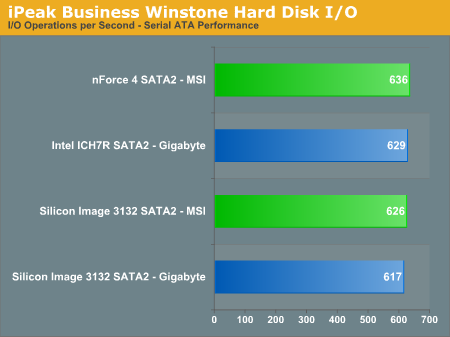
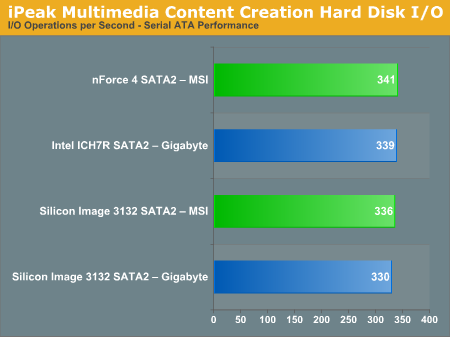
Firewire and USB Performance
After looking at many options for Firewire and USB testing, we finally determined that an external USB 2.0, Firewire 400, and Firewire 800 hard disk might be a sensible way to look at USB and Firewire throughput.
Our first efforts at testing with an IDE or SATA drive as the "server" yielded very inconsistent results, since Windows XP sets up cache schemes to improve performance. Finally, we decided to try a RAM disk as our "server", since memory removed almost all overhead from the serving end. We also managed to turn off disk caching on the USB and Firewire side by setting up the drives for "quick disconnect" and our results were consistent over many test runs.
We used 2GB of fast 3-2-2-4 system memory set up as a 450MB RAM disk and 1550MB of system memory. Our standard file is the SPECviewPerf install file, which is 432,533,504 bytes (412.4961MB). After copying this file to our RAM disk, we measured the time for writing from the RAM disk to our external USB 2.0 or Firewire 400 or Firewire 800 drive using a Windows timing program written for AnandTech by our own Jason Clark. The copy times in seconds were then converted into Megabits per second (Mb) to provide a convenient means of comparing throughput. Higher Rates, therefore, mean better performance.
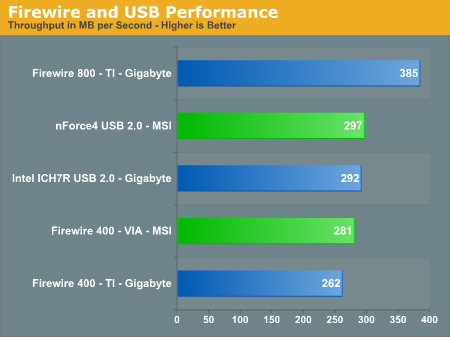
Our test is just one of many throughput tests, but in this benchmark, it is clear that the VIA Firewire 400 chip is faster than TI's 1394a chip. The NVIDIA nForce4 USB 2.0 controller is slightly faster than Intel's solution.
Ethernet Performance
As a refresher, the new motherboard test suite includes LAN performance measurements. Both of these boards utilize PCI Express controllers with the only difference being the supplier of the core logic.
The Windows 2000 Driver Development Kit (DDK) includes a useful LAN testing utility called NTttcp. We used the NTttcp tool to test Ethernet throughput and the CPU utilization of the various Ethernet Controllers used on the nForce4 Ultra motherboards.
We set up one machine as the server; in this case, an Intel box with an Intel CSA Gigabit LAN connection. Intel CSA has a reputation for providing fast throughput and this seemed a reasonable choice to serve our Gigabit LAN clients.
At the server side, we used the following Command Line as suggested by the VIA whitepaper on LAN testing:
Ntttcps - m 4,0, -a 4 - l 256000 - n 30000On the client side (the motherboard under test), we used the following Command Line:
Ntttcpr - m 4,0, -a 4 - l 256000 - n 30000At the conclusion of the test, we captured the throughput and CPU utilization figures from the client screen.
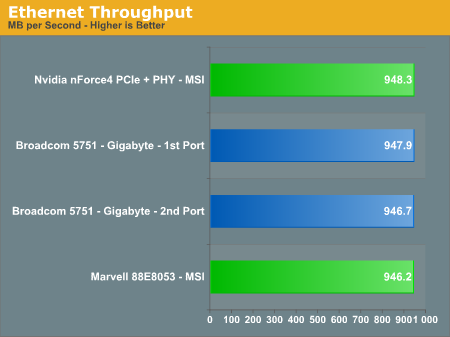
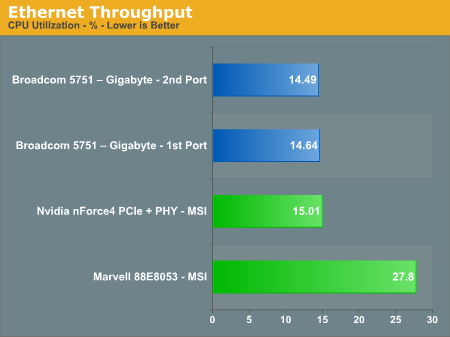
All Ethernet tests were performed with standard frames and the NVIDIA Active Armor suite disabled. Gigabit Ethernet supports Jumbo frames as well and will theoretically provide a further reduction in CPU overhead. We have seen test results that show the combination of Active Armor and Jumbo Frames have reduced CPU utilization below 10%, which is very respectable performance for on-chip gigabit LAN.
Audio Performance
We limited audio testing to the Rightmark 3D Sound version 2 CPU utilization test. This benchmark measures the overhead or CPU utilization required by a codec or hardware audio chip.
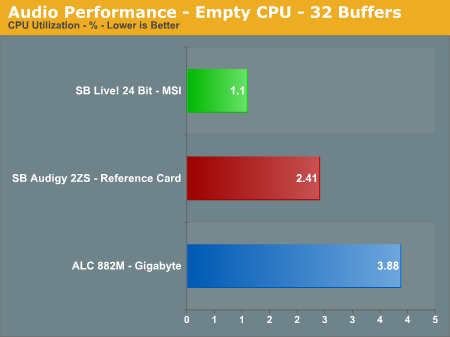
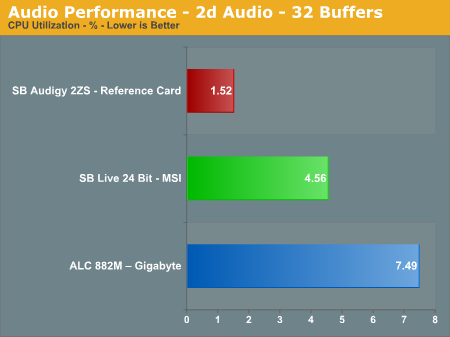
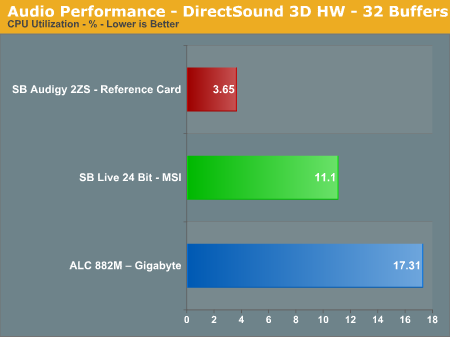
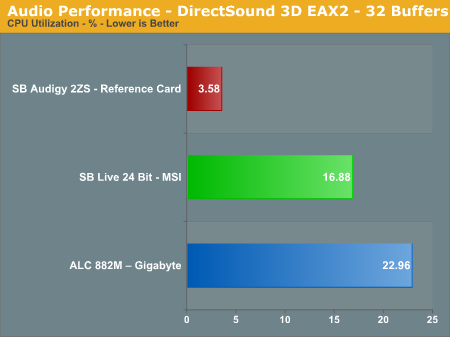
The Gigabyte's Realtek ALC 882M fully supports Intel's Azalia High Definition Audio standard and boasts impressive specifications for a host-based audio solution. Unfortunately, the Realtek ALC 882M does not fare as well against the Creative Sound Blaster Live! solution in the benchmarks. However, both MSI and Gigabyte deserve praise for offering solutions that a large majority of owners will find acceptable as an audio solution.
We will expand our audio testing in the future to include additional Rightmark 3D Sound results, RMAA 5.5 measurements to further clarify the quality of audio signals being generated, and a review of the software applications that ship with these on-board solutions.
Final Words
The MSI P4N Diamond and Gigabyte GA-8I955X are excellent products and reside at the upper echelon of each company's product line. Either board will, in some form or fashion, satisfy most computer enthusiasts who utilize Intel processors. Both boards are feature-laden with options that are very useful and include some that make for good marketing purposes.
Although the boards are very similar in several ways, they each cater to a different user, even though both are being marketed with the same message. These boards are strictly for the high-end user and as such, should be looked at with extra scrutiny. With that in mind, we offer the following comments.
In the processor area, if you use or plan to use a dual core processor, then the optimal solution at this time is the Gigabyte GA-8I955X Royal. It offers superior compatibility with the entire Intel Pentium D processor series, and full dual-core capabilities in all overclocking modes. However, if you do not plan on utilizing the Pentium D 820 processor or overclocking via the multiplier method then the MSI P4N should be given serious consideration when utilizing a Pentium D 830 or 840 series processor. Just keep in mind that the current NVIDIA nForce4 Intel Edition chipset does not support the value Pentium D 820 in dual-core mode and overclocking by multipliers will also disable the second core on other Intel dual-core processors. NVIDIA assures us this will be fixed in future chipsets.
In the video area, if you're a gamer looking for SLI, then the MSI P4N is your only choice. It fully supports NVIDIA SLI with two NVIDIA video cards. In the near future, Intel will release a revised chipset that will also fully support SLI operation.
In the on-board audio area, both boards offer excellent solutions with the Gigabyte GA-8I955X Royal offering full support for High Definition Azalia audio along with extensive features for the home audio user. The MSI P4N Diamond offers an even better option for the gamer with the Creative Sound Blaster Live! 24-bit solution. Both systems will fill the bill for most users, but serious gamers or audiophiles will want to seek better solutions.
In the storage area, both boards offer a plethora of options. MSI's nForce4 SLI Intel Edition Chipset offers the most native options and class leading performance. However, Gigabyte offers similar storage solutions along with Firewire 800 support that is not available on the MSI board. Both boards have exceptional capabilities with SATA II, flexible RAID options, PATA and full NCQ support. If your system requires a myriad number of drives, then the MSI P4N Diamond is the better board for you, but the Gigabyte's storage performance is also excellent.
In the performance area, both boards offered very good performance levels. Superior memory, disk, and overall application performance was offered by the nForce4 SLI Intel Edition chipset on the MSI P4N Diamond. If this type of performance is a priority, and it should be, then this is the board for you.
In the end, a Diamond does indeed beat a Royal Flush, but in this case, Gigabyte is holding the high ace. These high-end boards are best suited for the capabilities of the Intel Pentium D processor, and because of its full compatibility, the Gigabyte GA-8I955X Royal is the one and only choice.







